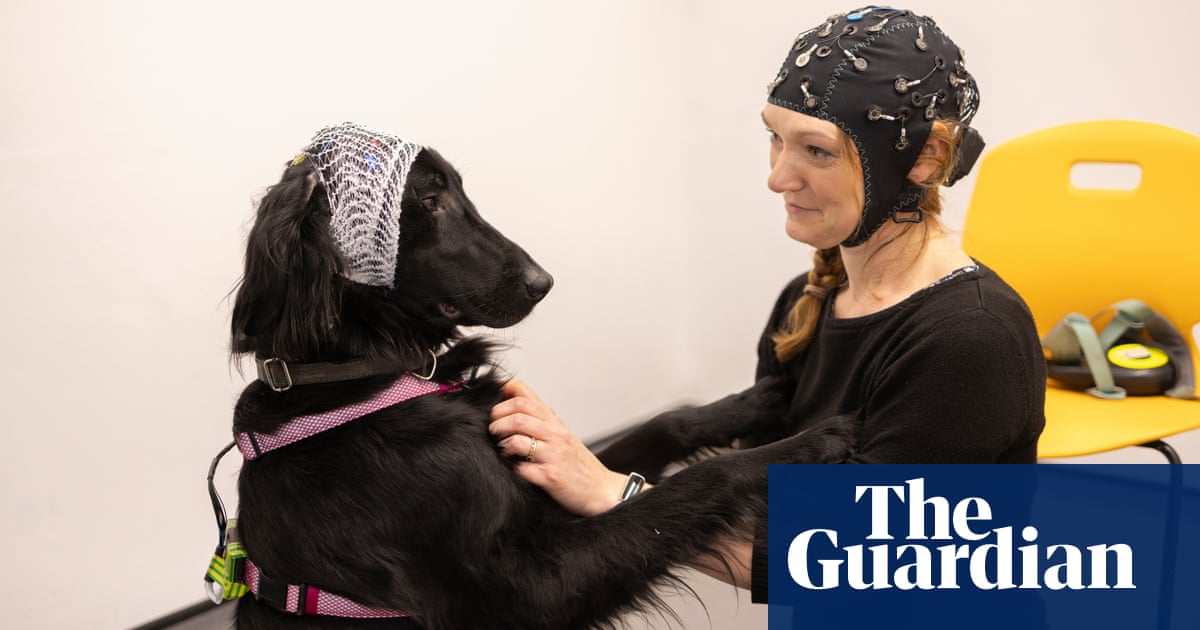Standing patiently on a small fluffy rug, Calisto the flat-coated retriever is being fitted with some hi-tech headwear. But this is not a new craze in canine fashion: she is about to have her brainwaves recorded.
Calisto is one of about 40 pet dogs – from newfoundlands to Tibetan terriers – taking part in a study to explore whether their brainwaves synchronise with those of their owners when the pair interact, a phenomenon previously seen when two humans engage with each other.
The researchers behind the work say such synchronisation would suggest person and pet are paying attention to the same things, and in certain circumstances interpreting moments in a similar way. In other words, owner and dog really are on the same wavelength.
Dr Valdas Noreika of the University of Cambridge said he got the idea for the study after working on similar experiments with mothers and their babies, where such synchronisation has also been seen.
“Owners modulate their language in a similar way as parents modulate when they speak to children,” he said.
“There are lots of similarities. That could be one of the reasons why we get so attached to dogs – because we already have these cognitive functions and capacities to attach with someone who is smaller or requires help or attention.”
Hints of an emotional bond between humans and their dogs stretch into the distant past: researchers have previously discovered the 14,000-year-old remains of a puppy buried in Germany alongside a man and a woman: the analysis suggested the young dog had been nursed through several periods of illness, despite having no particular use.
Yet Dr Eleanor Raffan, another member of the Cambridge team, noted some experts urged caution over making assumptions about the human-dog relationship, not least because it was easy to superimpose human motives and ways of thinking on to our pets.
“I think what would be lovely would be to prove that there is that connection,” she said.
The study involves making electroencephalogram (EEG) recordings – a noninvasive and painless technique that has also been used on parents and babies.
In the case of humans, a close-fitting cap, punctured with holes, is placed on to the participant’s head. The holes are filled with a gel and an electrode is attached to each – 32 in all. For dogs, a harmless white paste is used to temporarily hold a smaller array of 10 electrodes on their head, with a stretchy snood applied for extra security.
“Both the EEG caps are receivers, so they only detect electrical signals. They don’t generate any electricity,” said Ben Keep, a research assistant on the project.
Research published earlier this year by scientists in China suggested brainwave synchronisation occurs when humans and dogs look at each other, or when humans pet a dog.
However, that work drew criticisms, not least because the scientists attempted to investigate this further by giving LSD to dogs with a mutation that, they claimed, was associated with autism-like traits.
What is more, the human participants were not the dogs’ owners.
Calisto, now fitted with the headgear, is her usual bouncy self. But as Keep and Noreika dim the lights, she settles on the rug.
This part of the study, said Keep, allowed participants to relax and get used to the headwear, ensured the electrodes were properly attached and enabled the team to monitor brain activity while filming the duo’s behaviour. Crucially, it also allowed researchers to look for specific markers that were unlikely to arise from muscle activity – such as alpha brainwaves that occur when relaxed.
Next, a sequence of beeps, five low and one high-pitched, is played on loop – again to confirm the team are picking up brain activity.
“The brain responds to the deviant tones in a specific way that muscles would not,” said Keep.
In the experiments that follow, the owner is asked to switch their attention, on cue, between interacting with their dog and either looking at their phone, chatting to a researcher or stroking a cuddly toy. In another test, the team record what happens when the owner briefly leaves the dog.
The idea is that brainwave synchronisation should increase and decrease as attention is directed towards and away from the animal, with the video recordings additionally allowing the team to look for correlations between the EEG signals and behaviour. The latter can also be analysed alongside questionnaires completed by owners on their style of caregiving for further insights.
If brainwave synchrony is found, the team hope to unpick the phenomenon further. Synchronised brainwaves, for example, typically show a slight offset, suggesting one participant is leading the interaction.
“These synchronisation studies allow [us] to assess who is leading whom,” said Noreika.
And there could be practical applications from the findings. Among them, Noreika said experts may be able to use the approach to predict which individuals would gain most from therapy animals.
Dr Colleen Dell of the University of Saskatchewan, who was not involved in the work, said an important aspect was that it accounted for the experiences of the dog, adding that brainwave synchronisation could be complementary to body language as an indicator of canine contentment, happiness and satisfaction.
“If the results are positive – showing there is brainwave synchronisation between dogs and humans – it puts the possibilities of interspecies communication on the table too,” she said.
But, Dell cautioned, the work is a one-time study, examining very specific regions of the brain.
“We actually know very little about the human brain and its capacity, and so much, much less in dogs,” she said. “But again, just asking the question I think it is brilliant because it recognises the existence of the human-animal bond, and from there how some sense of it is being experienced for both the human and the dog.”





